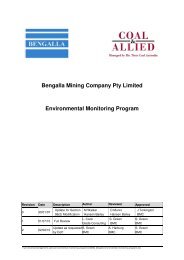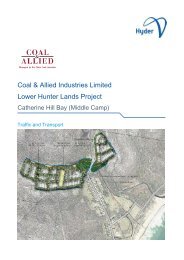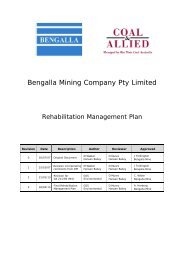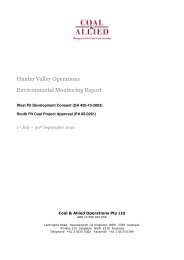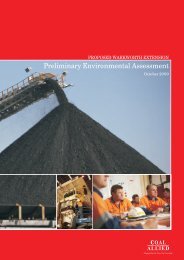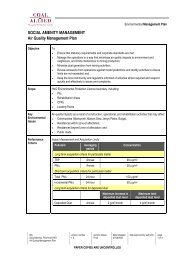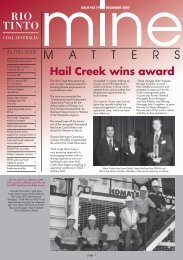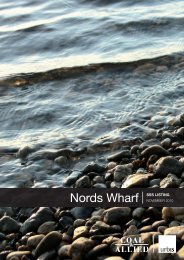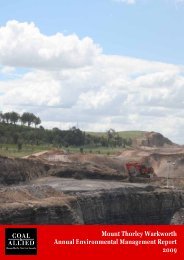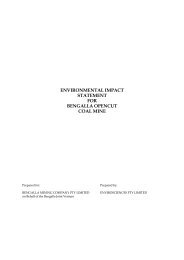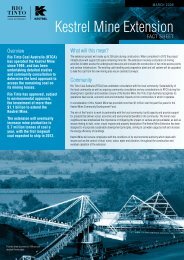HVO 2009 Annual Environmental Management Report - Final
HVO 2009 Annual Environmental Management Report - Final
HVO 2009 Annual Environmental Management Report - Final
You also want an ePaper? Increase the reach of your titles
YUMPU automatically turns print PDFs into web optimized ePapers that Google loves.
Coal & Allied – Hunter Valley Operations<br />
Water Outputs<br />
The main consumption of water in <strong>2009</strong> was for dust suppression on haul roads, mining areas and coal<br />
stockpiles (1,533ML) and CPP circuit losses (2,912ML). Evaporation from water storages and tailings dams<br />
was estimated at 2,034ML in <strong>2009</strong>.<br />
A total of 192ML of excess water was discharged off site during <strong>2009</strong> in accordance with the Hunter River<br />
Salinity Trading Scheme (HRSTS) and <strong>HVO</strong>’s EPL. Refer to Section 3.4.2 for further details.<br />
Water Storage and Transfer<br />
At the end of <strong>2009</strong> the overall volume of water stored at <strong>HVO</strong> had increased by 3,297ML. The primary storage<br />
for mine water is the North Pit Void. Storage in the North Pit Void increased by an estimated 989ML during<br />
<strong>2009</strong>. Use of water from the North Pit Void was limited in <strong>2009</strong> due to preferential use of water stored in pit.<br />
Water levels in the South Pit increased markedly over the year, accounting for about half the overall storage<br />
increase. Water levels in Riverview East Void (3,280ML) increased by 860ML. Riverview East Void was the<br />
primary dewatering destination from Cheshunt and Riverview mining pits in <strong>2009</strong>. Water from Riverview East<br />
Void was transferred back to the Hunter Valley CHPP via Dam 9N, and to the new storage in the Barry Pit<br />
Void which increased to 180ML. The Riverview East Void storage will be replaced by the Barry Pit storage in<br />
2010 as the Cheshunt Pit moves south west. Water stored in the North and South Auger Pits, South<br />
Lemington and several other small South Pit voids increased by 650ML.<br />
Parnells Dam is the main water storage for West Pit. Water stored in Parnells Dam and West Pit increased by<br />
330ML over the reporting period.<br />
2.8.2 Improvements to Mine Water <strong>Management</strong><br />
Improvements to mine water management in <strong>2009</strong> have focussed on improving mine water transfer,<br />
segregating clean and mining catchments and improvements to discharge points. This included:<br />
Implementation of clean water diversions for Carrington Pit and Riverview East Void;<br />
<br />
<br />
Constructing replacement storage for Riverview East Void in Barrys Pit; and<br />
Upgrade of discharge monitoring instrumentation at Parnells Dam and Dam 11N to improve operability<br />
and reduce risk of discharge non-compliance.<br />
2.8.3 Mine Water <strong>Management</strong> System<br />
The water management system is designed to contain all mine water arising from runoff within disturbed<br />
areas. Plans showing the layout of all water management structures and key pipelines are shown in Figure 11<br />
to Figure 13.<br />
West Pit<br />
West Pit mine water management structures (Figure 11) are based around Parnells Dam and the Emu Creek<br />
Dam (Dam 12W). Howick CPP, Industrial Area and Dams 2W to 6W contain process water.<br />
North Pit/Carrington<br />
North Pit mine water management structures (Figure 12) are Dams 9N, 11N, the South East Sump (21N) and<br />
the North Pit Tailings Dam (30N). Excess mine water from Carrington Pit is pumped into Dam 9N or to the<br />
South East Sump where it can be directed to the HVCPP, discharged or used for dust suppression. Water is<br />
recovered from the North Pit Tailings Dam via a surface pump. This water is pumped to Dam 9N or the South<br />
East Sump for use in the HVCPP or dust suppression. At the HVCPP and main Workshop, Dams 16N to 19N<br />
contain process water (a mixture of various water qualities) while Dam 15N is operated empty as an<br />
emergency storm buffer storage for overflows from Dam 16N and 19N.<br />
South Pit<br />
The Riverview East Void (Dam 20S) operates as a central mine water storage for the mining areas south of<br />
the Hunter River (Figure 13) receiving excess mine water from Cheshunt and Riverview Pits. This will be<br />
replaced by Barrys Void water storage in 2010 due to mining through Dam 20S. Water from Dam 20S is used<br />
for dust suppression or pumped to Dam 9N via the north south pipeline to supply the HVCPP. Water from<br />
Cheshunt and Riverview can also be pumped east to the Lake James (Dam 15S) discharge point. The East<br />
AEMR <strong>2009</strong> 43



